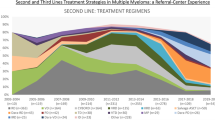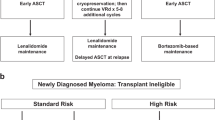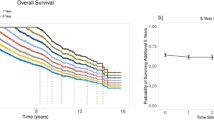Abstract
The concept of applying all active therapeutic agents in Total Therapy (TT) clinical trials for newly diagnosed multiple myeloma was pursued with the intent of developing curative treatment. The results of TT1 (n=231), TT2 (n=668) without or with thalidomide and TT3 with added bortezomib (n=303) have been reported. An update with median follow-up times of 17.1, 8.7 and 5.5 years, respectively, is provided. Conditional overall survival (OS) analysis from a 4-year landmark was applied to account for earlier protocol failure owing to disease aggressiveness and toxicities. Cumulative relative survival was computed in the context of age- and gender-matched US population, and interval-specific relative survival ratios were estimated to determine times to normal survival expectation. Based on Cox model-adjusted statistics, OS, progression-free survival and complete-response duration all improved with the transitions from TT1 to TT2 to TT3; improvement was also evident from time-to-progression estimates, 4-year conditional survival data and cumulative relative survival. Interval-specific relative survival normalized progressively sooner, reaching near-normal levels with TT3 in patients who attained complete response. Thus, a strategy using all myeloma-effective agents up-front seems effective at preventing, in progressively larger patient cohorts over time, the outgrowth of resistant tumor cells that account for ongoing relapses.
This is a preview of subscription content, access via your institution
Access options
Subscribe to this journal
Receive 12 print issues and online access
$259.00 per year
only $21.58 per issue
Buy this article
- Purchase on Springer Link
- Instant access to full article PDF
Prices may be subject to local taxes which are calculated during checkout





Similar content being viewed by others
References
Kumar SK, Rajkumar SV, Dispenzieri A, Lacy MQ, Hayman SR, Buadi FK et al. Improved survival in multiple myeloma and the impact of novel therapies. Blood 2008; 111: 2516–2520.
Palumbo A, Anderson K . Multiple myeloma. N Engl J Med 2011; 364: 1046–1060.
Zhou Y, Barlogie B, Shaughnessy JD . The molecular characterization and clinical management of multiple myeloma in the post-genome era. Leukemia 2009; 23: 1941–1956.
Barlogie B, Tricot GJ, van Rhee F, Angtuaco E, Walker R, Epstein J et al. Long-term outcome results of the first tandem autotransplant trial for multiple myeloma. Br J Haematol 2006; 135: 158–164.
Barlogie B, Tricot G, Anaissie E, Shaughnessy J, Rasmussen E, van Rhee F et al. Thalidomide and hematopoietic-cell transplantation for multiple myeloma. N Engl J Med 2006; 354: 1021–1030.
Barlogie B, Anaissie E, van Rhee F, Haessler J, Hollmig K, Pineda-Roman M et al. Incorporating bortezomib into upfront treatment for multiple myeloma: early results of Total Therapy 3. Br J Haematol 2007; 138: 176–185.
Nair B, van Rhee F, Shaughnessy JD, Anaissie E, Szymonifka J, Hoering A et al. Superior results of Total Therapy 3 (2003-33) in gene expression profiling-defined low-risk multiple myeloma confirmed in subsequent trial 2006-66 with VRD maintenance. Blood 2010; 115: 4168–4173.
Rajkumar SV, Harousseau JL, Durie B, Anderson KC, Dimopoulos M, Kyle R et al. Consensus recommendations for the uniform reporting of clinical trials: report of the International Myeloma Workshop Consensus Panel 1. Blood 2011; 117: 4691–4695.
Kaplan EL, Meier P . Nonparametric estimation using incomplete observations. J Am Stat Assoc 1958; 53: 457–481.
Gooley TA, Leisenring W, Crowley J, Storer BE . Estimation of failure probabilities in the presence of competing risks: new representations of old estimators. Stat Med 1999; 18: 695–706.
Mantel N . Evaluation of survival data and two new rank order statistics arising in its consideration. Cancer Chemother Rep 1966; 50: 163–170.
Cox DR . Regression models and life-tables. J Royal Stat Soc Ser B 1972; 34: 187–220.
Dickman PW, Sloggett A, Hills M, Hakulinen T . Regression models for relative survival. Stat Med 2004; 23: 51–64.
Jacobson J, Zhan F, Sawyer J, Tricot G, Barlogie B, Shaughnessy J . Gene expression reflects changes in ploidy of some, but not all chromosomes, in multiple myeloma. Blood 2002; 100: 316a.
Shaughnessy JD, Barlogie B . Integrating cytogenetics and gene expression profiling in the molecular analysis of multiple myeloma. Int J Hematol 2002; 76: 59–64.
Shaughnessy JD, Zhan F, Burington BE, Huang Y, Colla S, Hanamura I et al. A validated gene expression model of high-risk multiple myeloma is defined by deregulated expression of genes mapping to chromosome 1. Blood 2007; 109: 2276–2284.
Fonseca R . Risk-Adapted Therapy; Promises and Pitfalls.http://webcast.aacr.org/portal/p/2011annual/3577.
Frei E, Holland JF, Schneiderman MA, Pinkel D, Selkirk G, Freireich EJ et al. A comparative study of two regimens of combination chemotherapy in acute leukemia. Blood 1958; 13: 1126–1148.
Pui CH, Evans WE . Treatment of acute lymphoblastic leukemia. N Engl J Med 2006; 354: 166–178.
Barlogie B, Hittelman W, Spitzer G, Trujilo JM, Hart JS, Smallwood L et al. Correlation of DNA distribution abnormalities with cytogenetic findings in human adult leukemia and lymphoma. Cancer Res 1977; 37: 4400–4407.
San-Miguel JF, Mateos MV . Can multiple myeloma become a curable disease? Haematologica 2011; 96: 1246–1248.
Martinez-Lopez J, Blade J, Mateos MV, Grande C, Alegre A, García-Laraña J et al. Long-term prognostic significance of response in multiple myeloma after stem cell transplantation. Blood 2011; 118: 529–534.
Barlogie B, Crowley J . Could CR mean cure? Blood 2011; 118: 483.
Rajkumar SV, Gahrton G, Bergsagel PL . Approach to the treatment of multiple myeloma: a clash of philosophies. Blood 2011; 118: 3205–3211.
Richardson PG, Laubach J, Mitsiades CS, Schlossman R, Hideshima T, Redman K et al. Managing multiple myeloma: the emerging role of novel therapies and adapting combination treatment for higher risk settings. Br J Haematol 2011; 154: 755–762.
Hoering A, Crowley J, Shaughnessy JD, Hollmig K, Alsayed Y, Szymonifka J et al. Complete remission in multiple myeloma examined as time-dependent variable in terms of both onset and duration in Total Therapy protocols. Blood 2009; 114: 1299–1305.
Shaughnessy JD, Qu P, Usmani S, Heuck CJ, Zhang Q, Zhou Y et al. Pharmacogenomics of bortezomib test-dosing identifies hyperexpression of proteasome genes, especially PSMD4, as novel high-risk feature in myeloma treated with Total Therapy 3. Blood 2011; 118: 3512–3524.
Haessler J, Shaughnessy JD, Zhan F, Crowley J, Epstein J, van Rhee F et al. Benefit of complete response in multiple myeloma limited to high-risk subgroup identified by gene expression profiling. Clin Cancer Res 2007; 13: 7073–7079.
Zhan F, Barlogie B, Arzoumanian V, Huang Y, Williams DR, Hollmig K et al. Gene-expression signature of benign monoclonal gammopathy evident in multiple myeloma is linked to good prognosis. Blood 2007; 109: 1692–1700.
Kumar SK, Dingli D, Lacy MQ, Dispenzieri A, Hayman SR, Buadi FK et al. Outcome after autologous stem cell transplantation for multiple myeloma in patients with preceding plasma cell disorders. Br J Haematol 2008; 141: 205–211.
Dispenzieri A, Kyle R, Merlini G, Miguel JS, Ludwig H, Hajek R et al. International Myeloma Working Group guidelines for serum-free light chain analysis in multiple myeloma and related disorders. Leukemia 2009; 23: 215–224.
Paiva B, Martinez-Lopez J, Vidriales MB, Mateos MV, Montalban MA, Fernandez-Redondo E et al. Comparison of immunofixation, serum free light chain, and immunophenotyping for response evaluation and prognostication in multiple myeloma. J Clin Oncol 2011; 29: 1627–1633.
Corradini P, Voena C, Omedé P, Astolfi M, Boccadoro M, Dalla-Favera R et al. Detection of circulating tumor cells in multiple myeloma by a PCR-based method. Leukemia 1993; 7: 1879–1882.
Walker R, Barlogie B, Haessler J, Tricot G, Anaissie E, Shaughnessy JD et al. Magnetic resonance imaging in multiple myeloma: diagnostic and clinical implications. J Clin Oncol 2007; 25: 1121–1128.
Bartel TB, Haessler J, Brown TL, Shaughnessy JD, van Rhee F, Anaissie E et al. F18-fluorodeoxyglucose positron emission tomography in the context of other imaging techniques and prognostic factors in multiple myeloma. Blood 2009; 114: 2068–2076.
Zhou Y, Nair B, Shaughnessy JD, Cartron MA, Haessler J, Anaissie E et al. Cytogenetic abnormalities in multiple myeloma: poor prognosis linked to concomitant detection in random and focal lesion bone marrow samples and associated with high-risk gene expression profile. Br J Haematol 2009; 145: 637–641.
Anaissie EJ, van Rhee F, Hoering A, Waheed S, Alsayed Y, Petty N et al. Comparing toxicities and survival outcomes with Total Therapy 4 (TT4) for 70-gene (R70)-defined low-risk multiple myeloma (MM) to results obtained with Total Therapy 3 protocols TT3A and TT3B. Blood 2010; 116: 368.
Bladé J, Rosiñol L . Refining ‘total therapy’ for myeloma. Blood 2010; 115: 4152–4153.
Facon T, Avet-Loiseau H, Guillerm G, Moreau P, Geneviève F, Zandecki M et al. Chromosome 13 abnormalities identified by FISH analysis and serum beta2-microglobulin produce a powerful myeloma staging system for patients receiving high-dose therapy. Blood 2001; 97: 1566–1571.
Gertz MA, Lacy MQ, Dispenzieri A, Greipp PR, Litzow MR, Henderson KJ et al. Clinical implications of t(11;14)(q13;q32), t(4;14)(p16.3;q32), and -17p13 in myeloma patients treated with high-dose therapy. Blood 2005; 106: 2837–2840.
Avet-Loiseau H, Soulier J, Fermand JP, Yakoub-Agha I, Attal M, Hulin C et al. Impact of high-risk cytogenetics and prior therapy on outcomes in patients with advanced relapsed or refractory multiple myeloma treated with lenalidomide plus dexamethasone. Leukemia 2010; 24: 623–628.
Shaughnessy JD, Haessler J, van Rhee F, Anaissie E, Pineda-Roman M, Cottler-Fox M et al. Testing standard and genetic parameters in 220 patients with multiple myeloma with complete data sets: superiority of molecular genetics. Br J Haematol 2007; 137: 530–536.
Shaughnessy JD, Zhou Y, Haessler J, van Rhee F, Anaissie E, Nair B et al. TP53 deletion is not an adverse feature in multiple myeloma treated with total therapy 3. Br J Haematol 2009; 147: 347–351.
Broyl A, Hose D, Lokhorst H, de Knegt Y, Peeters J, Jauch A et al. Gene expression profiling for molecular classification of multiple myeloma in newly diagnosed patients. Blood 2010; 116: 2543–2545.
Barlogie B, Smallwood L, Smith T, Alexanian R . High serum levels of lactic dehydrogenase identify a high-grade lymphoma-like myeloma. Ann Intern Med 1989; 110: 521–525.
Nair BP, Waheed S, Hoering A, VanRhee F, Anaissie EJ, Lorsbach R et al. Primary plasma cell leukemia (PCL): clinical and laboratory presentation and clinical outcome with total therapy (TT) protocols. J Clin Oncol 2010; 28: 15s.
Avet-Loiseau H, Daviet A, Brigaudeau C, Callet-Bauchu E, Terré C, Lafage-Pochitaloff M et al. Cytogenetic, interphase, and multicolor fluorescence in situ hybridization analyses in primary plasma cell leukemia: a study of 40 patients at diagnosis, on behalf of the Intergroupe Francophone du Myélome and the Groupe Français de Cytogénétique Hématologique. Blood 2001; 97: 822–825.
Shaughnessy JD, Zhan F, Burington BE, Huang Y, Colla S, Hanamura I et al. A validated gene expression model of high-risk multiple myeloma is defined by deregulated expression of genes mapping to chromosome 1. Blood 2007; 109: 2276–2284.
Broyl A, Hose D, Lokhorst H, de Knegt Y, Peeters J, Jauch A et al. Gene expression profiling for molecular classification of multiple myeloma in newly diagnosed patients. Blood 2010; 116: 2543–2553.
Zhan F, Huang Y, Colla S, Stewart JP, Hanamura I, Gupta S et al. The molecular classification of multiple myeloma. Blood 2006; 108: 2020–2028.
Magrangeas F, Nasser V, Avet-Loiseau H, Loriod B, Decaux O, Granjeaud S et al. Gene expression profiling of multiple myeloma reveals molecular portraits in relation to the pathogenesis of the disease. Blood 2003; 101: 4998–5006.
Avet-Loiseau H, Mallard F, Campion L, Magrangeas F, Sebban C, Lioure B et al. Translocation t(14;16) and multiple myeloma: is it really an independent prognostic factor? Blood. 2011; 117: 2009–2011.
Nair B, Shaughnessy JD, Zhou Y, Astrid-Cartron M, Qu P, van Rhee F et al. Gene expression profiling of plasma cells at myeloma relapse from tandem transplantation trial Total Therapy 2 predicts subsequent survival. Blood 2009; 113: 6572–6575.
Bladé J, Fernández de Larrea C, Cibeira MT, Jiménez R, Powles R . Soft-tissue plasmacytomas in multiple myeloma: incidence, mechanisms of extramedullary spread, and treatment approach. J Clin Oncol 2011; 29: 3805–3812.
Usmani SZ, Mitchell A, Szymonifka J, Shaughnessy JD, Hoering A, Alsayed Y et al. Extramedullary disease (EMD): a common terminal pathway in multiple myeloma (MM) progression. J Clin Oncol 2011; 29: 8068.
Acknowledgements
We recognize Mr Nathan Petty, Ms Susan Panozzo, Mr Doug Steward, Mr Clyde Bailey, the UAMS-MIRT data management team, the UAMS-MIRT nursing staff, referring physicians and our patients—without whom this body of work would not be possible. The manuscript was edited by Peggy Brenner, Office of Grants and Scientific Publications, University of Arkansas for Medical Sciences. This work has been supported by a grant from the National Cancer Institute, the National Institutes of Health (grant number CA 55813).
Author information
Authors and Affiliations
Corresponding author
Ethics declarations
Competing interests
Dr Usmani is a consultant to Celgene, Millennium and Onyx and has received speaking honoraria from Celgene. Dr Barlogie has received research funding from Celgene and Novartis. He is a consultant to Celgene and Genzyme and has received speaking honoraria from Celgene and Millennium. Dr Barlogie is a co-inventor on patents and patent applications related to use of GEP in cancer medicine.
Additional information
Supplementary Information accompanies the paper on the Leukemia website
Supplementary information
Rights and permissions
About this article
Cite this article
Usmani, S., Crowley, J., Hoering, A. et al. Improvement in long-term outcomes with successive Total Therapy trials for multiple myeloma: are patients now being cured?. Leukemia 27, 226–232 (2013). https://doi.org/10.1038/leu.2012.160
Received:
Revised:
Accepted:
Published:
Issue Date:
DOI: https://doi.org/10.1038/leu.2012.160
Keywords
This article is cited by
-
Conditional survival in multiple myeloma and impact of prognostic factors over time
Blood Cancer Journal (2023)
-
Long PFS of more than 7 years is achieved in 9% of myeloma patients in the era of conventional chemotherapy and of first-generation novel anti-myeloma agents: a single-center experience over 20-year period
Annals of Hematology (2020)
-
Characteristics of exceptional responders to autologous stem cell transplantation in multiple myeloma
Blood Cancer Journal (2020)
-
Clinical predictors of long-term survival in newly diagnosed transplant eligible multiple myeloma — an IMWG Research Project
Blood Cancer Journal (2018)
-
Safety and comfort of domestic bortezomib injection in real-life experience
Supportive Care in Cancer (2018)



